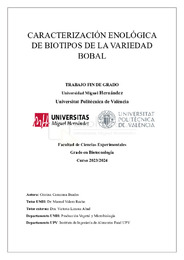Por favor, use este identificador para citar o enlazar este ítem:
https://hdl.handle.net/11000/33069Registro completo de metadatos
| Campo DC | Valor | Lengua/Idioma |
|---|---|---|
| dc.contributor.advisor | Valero Roche, Manuel | - |
| dc.contributor.advisor | Lizama Abad, Victoria | - |
| dc.contributor.author | Camarasa Buades, Cristina | - |
| dc.contributor.other | Departamentos de la UMH::Producción Vegetal y Microbiología | es_ES |
| dc.date.accessioned | 2024-09-11T12:45:24Z | - |
| dc.date.available | 2024-09-11T12:45:24Z | - |
| dc.date.created | 2024-06 | - |
| dc.identifier.uri | https://hdl.handle.net/11000/33069 | - |
| dc.description.abstract | Con el paso del tiempo, la producción de los vinos, la superficie del viñedo y el consumo del vino se ha visto reducido drásticamente, lo cual lleva a los agricultores y enólogos a la búsqueda de mejoras en el sector. Entre estas, se encuentra la selección clonal, una técnica que permite seleccionar los mejores genotipos, con el fin de obtener vinos de mayor calidad. En la cultura vinícola o vitivinícola valenciana, se encuentra la variedad Bobal considerada la estrella de la Denominación de Origen Utiel-Requena. Esta destaca por sus elevados niveles de polifenoles y acidez, su alta productividad y la resistencia a la sequía, la cual da lugar a vinos tintos y rosados. Sin embargo, su principal problema radica en la compacidad entre sus bayas, ya que afecta directamente al estado sanitario de la uva. En el presente trabajo se ha llevado a cabo una selección de 8 clones diferentes de la variedad Bobal, estos han sido plantados en cuatro parcelas distintas. Con el fin de seleccionar el mejor clon, se han llevado a cabo analíticas para estudiar su concentración polifenólica, entre otros. Los resultados muestran que, aunque todos los clones son capaces de producir vino, el clon 11.5 sobresale con respecto al resto. | es_ES |
| dc.description.abstract | Over time, wine production, vineyard surface area and wine consumption have been drastically reduced, leading growers and winemakers to search for improvements in the sector. Among these techniques we have clonal selection, that allows the selection of the best genotypes in order to obtain higher quality wines. In the Valencian wine culture, the Bobal variety is considered the star of the Utiel-Requena Denomination of Origin. This variety stands out for its high levels of polyphenols and acidity, its high productivity and resistance to drought, which gives rise to red and rosé wines. However, its main problem lies in the compactness of its berries, which directly affects the health status of the grapes. In the present work, a selection of 8 different clones of the Bobal variety was carried out, which were planted in four different plots. In order to select the best clone, analyses were carried out to study its polyphenolic concentration, among others. The results show that, although all clones can produce wine, clone 11.5 stands out from the rest. | es_ES |
| dc.format | application/pdf | es_ES |
| dc.format.extent | 41 | es_ES |
| dc.language.iso | spa | es_ES |
| dc.publisher | Universidad Miguel Hernández de Elche | es_ES |
| dc.rights | info:eu-repo/semantics/openAccess | es_ES |
| dc.rights.uri | http://creativecommons.org/licenses/by-nc-nd/4.0/ | * |
| dc.subject | Vitis vinifera L. | es_ES |
| dc.subject | Selección clonal | es_ES |
| dc.subject | Variedad Bobal | es_ES |
| dc.subject | Denominación Origen Utiel-Requena | es_ES |
| dc.subject | Polifenoles | es_ES |
| dc.subject | Clonal selection | es_ES |
| dc.subject | Bobal variety | es_ES |
| dc.subject | Utiel-Requena Denomination Origin | es_ES |
| dc.subject | Polyphenols | es_ES |
| dc.subject.other | CDU::5 - Ciencias puras y naturales::58 - Botánica | es_ES |
| dc.title | Caracterización enológica de biotipos de la variedad bobal | es_ES |
| dc.type | info:eu-repo/semantics/bachelorThesis | es_ES |

Ver/Abrir:
CAMARASA BUADES CRISTINA.pdf
1,59 MB
Adobe PDF
Compartir:
 La licencia se describe como: Atribución-NonComercial-NoDerivada 4.0 Internacional.
La licencia se describe como: Atribución-NonComercial-NoDerivada 4.0 Internacional.
.png)